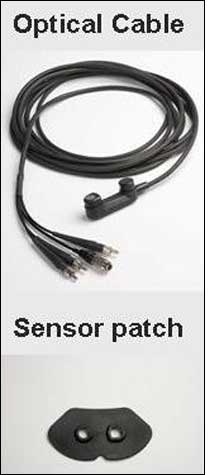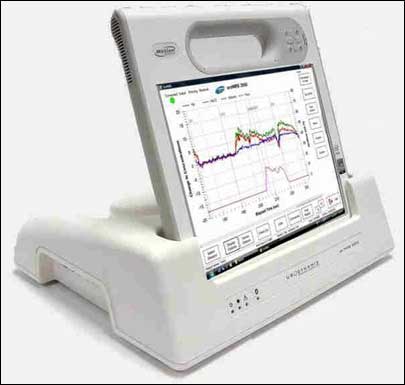Urodynamix Technologies, a Canadian medical device company, has partnered with wireless network provider Motion Computing to offer a bladder-monitoring system that leverages radio frequency identification to improve the product’s safety.
Urodynamix’s UroNIRS 2000 Bladder Monitor System is a standalone device that employs near-infrared spectroscopy (NIRS)—a spectroscopic method utilizing the near-infrared region of the electromagnetic spectrum (wavelengths that are 800 to 2,500 nanometers)—to measure changes in blood flow in a patient’s bladder and abdominal walls. Near-infrared emissions consist of the spectrum just beyond red light, and are invisible to humans. The system is designed to help physicians diagnose and treat enlarged prostates, prostatic cancer and other health problems related to the bladder and prostate gland.
The UroNIRS 2000 Bladder Monitor System includes a base station, built by Urodynamix, and Motion Computing’s Motion C5 mobile clinical assistant (MCA), a handheld tablet PC that comes with a built-in Bluetooth transceiver and a 13.56 MHz RFID interrogator compliant with the ISO 15693 standard. The C5 fits into the base station, which analyzes data collected from an adhesive patch with fiber-optic cables that connect to the station.
Designed to be affixed to a patient’s skin during testing, the patch contains a light emitter that projects near-infrared light, and a sensor that can receives near-infrared waves reflected back by the patient’s internal organs. The patch collects the waves reflecting from that person’s organs and sends them, via the fiber-optic cable, to the base station, where they are processed and converted to digital data. The C5 then displays the test results in real time, so physicians can discuss the findings with patients in the examination room. The C5 can utilize its integrated Bluetooth technology to download data from the base station, thereby eliminating the need for the device to be docked in the base station in order to access and display the test results.
The C5’s RFID reader is used to capture the unique ID numbers from passive RFID tags embedded in the packaging of the single-use patches. Doctors can easily scan a patch prior to each test to enhance patient safety by ensuring each patch is used only on a single patient, thus eliminating the spread of infection that might result from attaching the same patch to multiple individuals.
“A common problem in the medical device industry is the reuse of single-use, disposable components, and there are reasons why we don’t want that to happen,” says Barry Allen, CEO of Urodynamix, headquartered in Vancouver, British Columbia. “First and foremost, there’s patient safety.”
To use the RFID capability, a physician enters the patient’s name into the C5, then waves the device over each patch (the read distance is 1 to 2 inches) just before affixing the patches to the patient. When the C5 reads the patch’s tag, the system associates the tag ID number with that person’s name, along with the date and time, then permits the test to be carried out. Later that day, if the patient needs to be retested, the UroNIRS 2000 Bladder Monitor System will let the doctor reuse the patch on that same patient within a specific period of time. If, however, the system is presented with a patch that had already been utilized for a different individual, it will issue an alert and not allow testing to proceed.
In addition, Urodynamix’s distributors can leverage the RFID tags to ensure customers purchase patches only from them. “The RFID tags offer protection to our distributors,” Allen explains, “some of which want to sell the system on the assumption that they will get revenue from the consumables used with that device.” The distributor can buy batches of RFID-enabled tags with unique ID numbers that include its company code, and those tag numbers can be preprogrammed into the UroNIRS Bladder Monitor System. If the monitor fails to capture a tag number, or if the tag number it captures is not one preprogrammed by the company, the system will not operate.
In early January 2009, the U.S. Food and Drug Administration granted Urodynamix permission to market the device, as required by Section 510(k) of the Food, Drug and Cosmetic Act. With such clearance, the UroNIRS 2000 Bladder Monitor System can be marketed and commercially distributed within the United States. Urodynamix has also applied for the CE mark for European approval of the device, which it expects to receive in the first quarter of 2009, for a European launch in the second quarter.
The UroNIRS 2000 Bladder Monitor System is available now.



